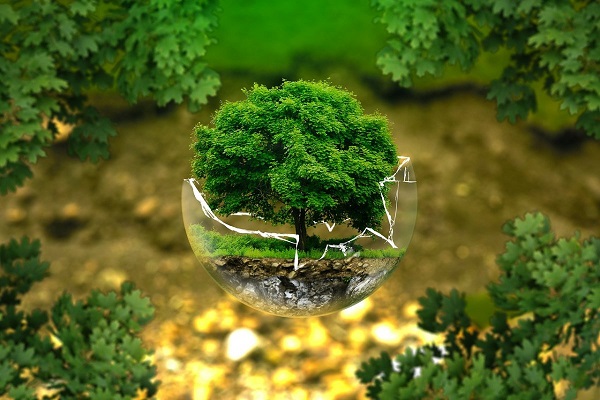There is almost not a single person who hasn’t heard of the phenomenon called the greenhouse effect. Putting it almost always in a negative connotation, many don’t even know that it is a natural phenomenon, which has been present in our universe for almost four billion years. Its presence is a precondition and enables the entire life on our planet Earth.
The natural phenomenon – greenhouse effect, which takes place through greenhouse gasses (primarily carbon dioxide – СО2, carbon monoxide – СО, ozone – О3, sulfur hexaflouride – SF6, water vapor – Н2О, methane – CH4 and nitrous oxide – N2O), enables solar energy to penetrate to Earth and fall on it as light. That light then returns to the atmosphere in the form of infrared (heat) radiation and heats it.
This phenomenon keeps our planet warm enough, providing conditions for all physiological roles of living organisms to function normally. The absence of greenhouse gasses would lower the temperature on Earth for about 33℃, turning it into another lifeless planet of the solar system.
The greenhouse effect, having been a blessing for the Earth the entire time, seems to have transformed into a serious threat the past century, caused by human activities. With industrialization and urbanization, production of electricity and thermal energy, senseless destruction of forests and appropriation of land for agricultural activities, use of transportation means for the needs of the ever increasing number of citizens, emission of greenhouse gasses (caused by burning of fossil fuel – coal, oil and gas), it has constantly risen.
In the past hundred years, people have emitted greenhouse gasses into the atmosphere faster that the natural processes could eliminate them.
As far back as 1896, Swedish chemist Svante Arrhenius anticipated the intensified greenhouse effect. He came to a conclusion that due to the increased quantity of CO2 in the atmosphere, there would be a rise in the Earth’s temperature. His predictions were ignored, as at that time no one could have even sensed that the industry would develop at such a fast pace and that it would have an enormous impact on climate change at the global level. Today, this is exactly what is happening.
With the purpose to prove the suspicion of scientists that the basic composition of the atmosphere is changing, in lack of a sufficient number of arguments, in the second half of the last century, long-term measurements were conducted of the level of carbon dioxide – CO2 in the atmosphere.
Of the results that had been obtained with direct measurements, which had started in 1957, in conditions of an unpolluted nature on Mauna Loa in Hawaii, and later in other places too, atmospheric chemists had come to a conclusion that the composition of the atmosphere was significantly changing. The change referred to increased levels of carbon dioxide – CO2, methane – CH4, nitrous oxide – N2O and chlorofluorocarbons CFC in the atmosphere.
Not so long ago, the quantity of these gasses in the atmosphere reached its maximum in relation to the past 420 thousand years. With the increase in the concentration of these gasses in the atmosphere, increasingly more heat is being accumulated on Earth’s surface, causing warming that has climate change as a consequence.
Recent climate change has already affected many natural physiological and biological systems. In many regions around the world there has been melting of ice shields, reduction of glaciers, late freeze or earlier melting of ice in certain rivers and lakes, extinction of some plant and animal species, early blooming of trees, appearance of unusual types of insects…
Changes caused by ever more frequent droughts or floods have a socio-economic character and are often accompanied by demographic shifts.
Climate change is unfavorable to systems that are directly related to human existence, such as water resources (drinking water), agriculture, forestry, coastal belts, industry, energy, health…
During the 1980s, scientific evidence on global climate change and its consequences caused growing concern among scientists, politicians and the public. As a result of that concern, in Rio de Janeiro, (in 1992), the UN Framework Convention on Climate Change – UNFCCC) was adopted, within which framework a series of obligations are defined that apply to all countries, and refer to the development and implementation of policies for reduction of the greenhouse effect.
The response of the developed countries, which, by the way, are also the largest producers of greenhouse gasses, was very weak. In 1995, in Berlin, the Berlin Mandate was presented with which a negotiating process was established with the purpose to reinforce the engagement of the most developed countries for the period beyond 2000.
This process, finally resulted in the adoption of the Kyoto Protocol (KP) in 1997, legally binding developed countries to reduce the emission of harmful gasses for the period 2008 – 2012. The protocol was further upgraded and extended.
With its application, the rise in the level of carbon dioxide in the atmosphere would be prevented, and later it would also decrease (at the level of before the industrial revolution). The consistent application of the protocol envisions normalization of the situation by 2050.
It’s more than obvious that the global warming of our planet is of distressing proportions with a tendency for further worsening of the situation. Therefore, every modern and socially responsible state should pass and implement measures that will mitigate and prevent global warming, even though they will further have implications on the economic development and overall on all aspects of everyday life.
Citizens, through the process of education, also need to contribute in the effort of reducing the consequences of global warming (less use of transportation means, planting of new trees, rational use of energy, collecting or recycling waste, using cloth bags instead of plastic bags and so on).
“The cost of prevention is much smaller than the consequences of climate deterioration” – Jan Pronk
by: Natasa Malinka Minovska
translation: N. Cvetkovska
https://en.wikipedia.org/wiki/Greenhouse_effect
https://prirodecuvar.weebly.com/opscaronte/efekat-staklene-baste
http://infogim.weebly.com/uploads/
https://vdocuments.pub/sta-je-efekat-staklene-baste-bulatovic-nedic-marjanovic.html
http://www.ff.bg.ac.rs/Katedre/Atomska/SiteAtomska/Dodatna%20literatura/globalno_zagrevanje_kolarac.pdf
https://www.postposmo.com/bs/efekat-staklene-baste/
http://elektroluks.net.mk/documents/doc_view/6-globalno-zagrevawe-na-zemjata-pricini-posledici-i-merki-akedemija-elektroluks.raw?tmpl=component
https://www.renovablesverdes.com/mk/causas-del-efecto-invernadero/https://climatekids.nasa.gov/greenhouse-effect/
https://andreslinares.me/efekat-staklene-baste-90/
This post is also available in: MacedonianAlbanian





